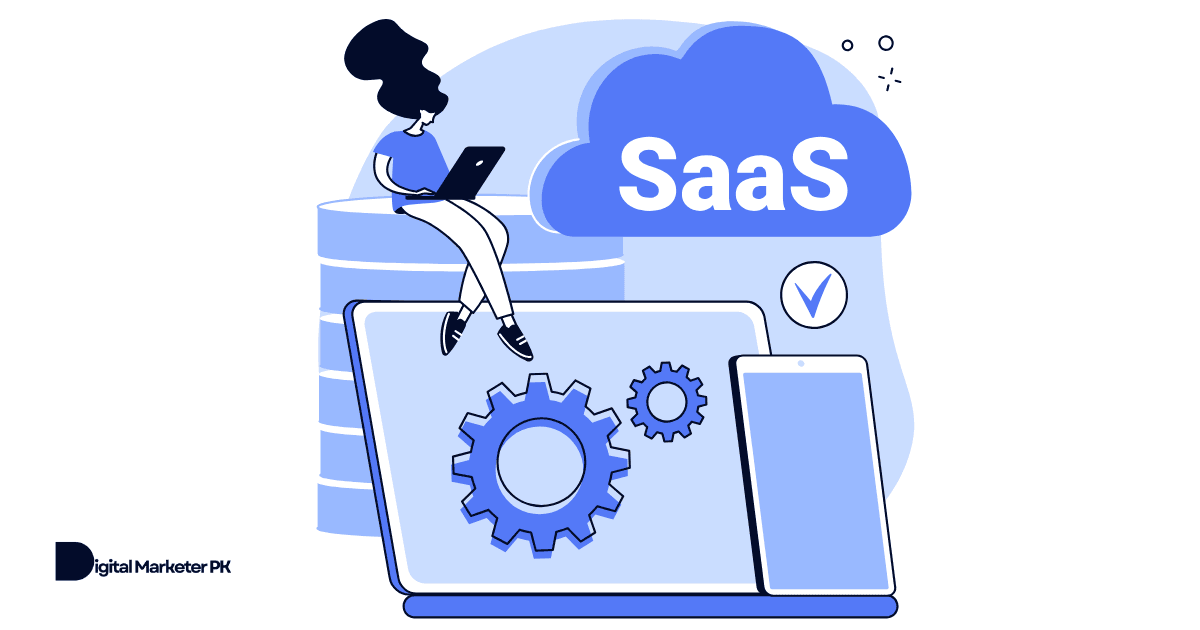Generating traffic for a SaaS business is expensive and challenging. While PPC is a decent option to generate traffic, it isn’t sustainable. When you stop your ads, you don’t receive any traffic (and sales plummet).
It also increases customer acquisition cost significantly.
Inbound marketing, on the other hand, is a cost-effective, long-term, sustainable, and scalable marketing approach for SaaS brands.
If you haven’t thought about inbound marketing for SaaS, it’s time you do.
This article explains why inbound marketing is essential for your SaaS company, how it’s different from outbound marketing, how it works, and how you can create an inbound marketing strategy for your company.
What is Inbound Marketing?
Inbound marketing is a subset of digital marketing that focuses on attracting customers via useful content and exceptional experience. It relies on creating and publishing helpful content for your target audience that helps you build lasting relationships with your ideal customers.
The core of inbound marketing is that potential customers come to you (inbound) after reading awesome content on the internet published by your SaaS business. This is the opposite of online ads where you reach out to your target audience via ads (mostly interrupted).
Here’s how inbound marketing works:
- You create and publish quality content on your blog and other platforms
- Your target audience finds your content while researching a solution for a problem
- The content helps them solve their problem and they engage with your brand
- Engagement begins between you and potential customers.
The engagement with your company in case of inbound marketing is initiated by the customer – not you – and therefore, the name ‘inbound’.
Inbound marketing covers the entire SaaS funnel from attracting to delighting a customer:

Essentially, an inbound marketing strategy focuses on:
- Content creation and promotion to attract potential customers
- Landing pages for conversions
- Email marketing for lead engagement and sales
- Marketing automation for delighting customers.
Inbound Marketing Benefits for SaaS
Here’s a list of the top benefits that a SaaS brand enjoys when it engages in inbound marketing:
Customer Centric
Inbound marketing focuses on offering exceptional user experience (UX) to your ideal customers. It follows a customer-centric approach as you create and publish content your target audience is interested in.
Since it focuses on your ideal customers, it makes inbound marketing ideal for both B2C and B2B SaaS companies.
Cost-Effective
Inbound marketing is quite cheap in terms of customer acquisition cost compared to other forms of digital marketing.
A study reported that inbound marketing costs $14 less than traditional marketing to acquire a new customer, it can help marketers save up to 62%, and leads acquired through inbound marketing are 80% less expensive than outbound leads.
Low customer acquisition cost (CAC) is ideal for SaaS businesses as it increases customer lifetime value which leads to higher profitability with a balanced business model.
Sustainable and Scalable
Since inbound marketing uses content publication, this makes it quite sustainable. It doesn’t need regular investment like online ads where you have to keep your ads running to generate traffic.
The content you publish today will continue to drive organic visitors to your site for years to come without additional investment.
Naturally, inbound marketing is scalable as more content means more impressions and clicks in SERPs.
Diversification
Inbound marketing uses a wide range of channels to drive traffic to your SaaS website. It includes all types and formats of content that you publish across channels. Such as blog posts, video content on social platforms, social posts, infographics, audio content, webinars, whitepapers, case studies, etc.
This diversification of channels is ideal for your SaaS company as you have multiple channels to connect with your audience.
More Conversions
B2B SaaS businesses that have a solid inbound marketing strategy generate up to 126% more leads.
The inbound marketing conversion rate is much higher as it attracts ideal customers via high quality content. When you keep publishing helpful content, it improves your brand credibility and eventually, your target audience will choose you over competitors.
Builds and Nurtures Relationships
The core of inbound marketing is building and nurturing relationships with customers. It pays off big time.
Having strong relationships with your customers increases the retention rate and reduces the churn rate significantly. And you’ll have a lot of satisfied and loyal customers who’ll stick with your SaaS brand due to the personalized treatment they receive.
Inbound Vs. Outbound Marketing
These two marketing types differ in the way you reach and connect with your customers.
Outbound marketing involves tactics to reach your target audience. You have to actively engage in marketing to stay connected with your ideal customers. Examples of outbound marketing include Google Ads, Meta Ads, TV and radio ads, direct mail, billboards, cold calling, and other tactics where you actively try to reach your audience.
Inbound marketing is permission-based marketing where your audience approaches you after engaging with content that you published or own. Your content brings ideal customers to your brand and the interaction with your company is initiated by your audience. Examples of inbound marketing tactics include blog, social media posts and shares, customer reviews, video and audio content, and other forms of content that you have published to reach and attract your target audience.

Outbound marketing is intrusive as it focuses on paid marketing channels that, usually, reach people without their consent. For instance, the ads you see in your news feed on Facebook or Instagram are intrusive as you didn’t opt for those ads and neither you are there to see ads.
This interruption isn’t found in inbound marketing where people approach your SaaS company organically. For example, a person searching for team communication tips in Google and visits your SaaS blog. After reading the article, the person subscribes to your newsletter because your article is impressive and helped him solve a problem. That’s how an interaction with your software company is initiated by a potential customer.
Both inbound and outbound marketing have their ups and downs. These marketing strategies aren’t substitutes rather complement each other. Best SaaS brands use both outbound and inbound marketing together to generate sales through paid and organic channels.
How Inbound Marketing Works
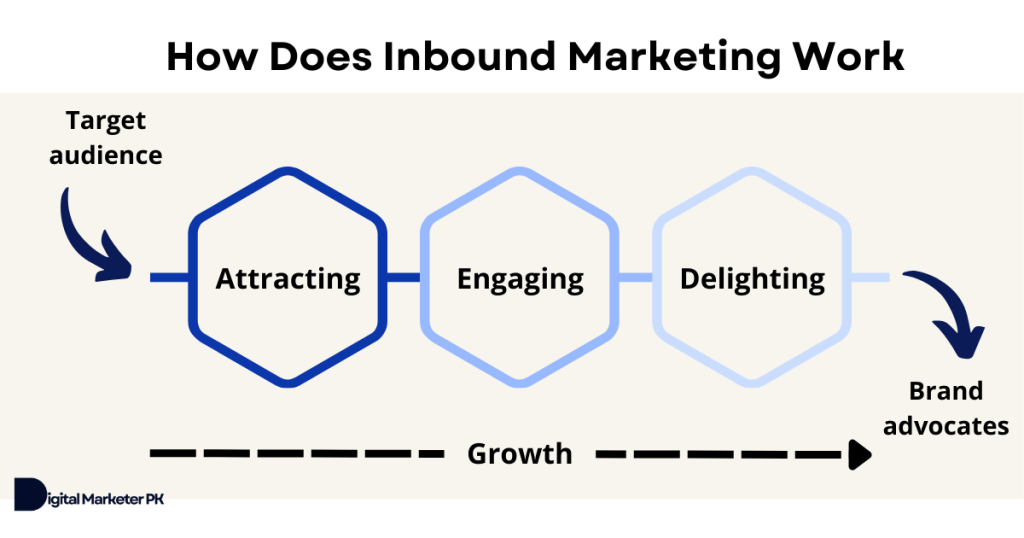
Inbound marketing works in 3 stages covering your entire sales funnel:
- Attracting target audience
- Engaging potential customers
- Delighting customers.
1. Attracting Target Audience
The content you publish across different channels attracts potential customers at the top of the funnel.
Attracting your target audience and pushing them to your SaaS sales funnel is the first step of inbound marketing methodology. You do this by creating and publishing highly valuable and helpful content on your blog and social media.
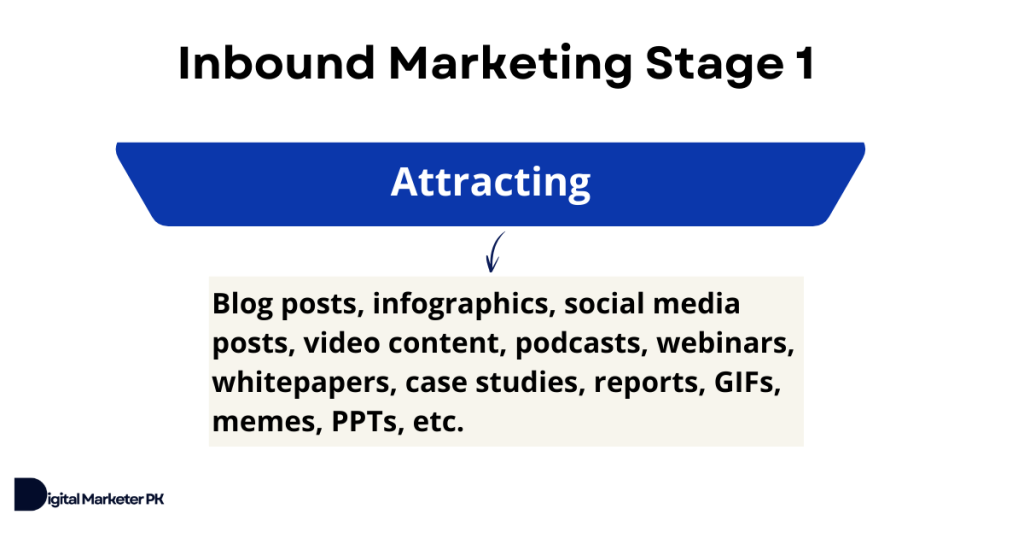
2. Engaging Potential Customers
Engagement covers the top and mid funnel where you actively interact with potential buyers. Once someone enters your sales funnel, you have their email address and other contact details which makes it easy to nurture leads.
Email is the best channel to interact and engage with potential customers. Other engagement techniques include remarketing ads and marketing automation.
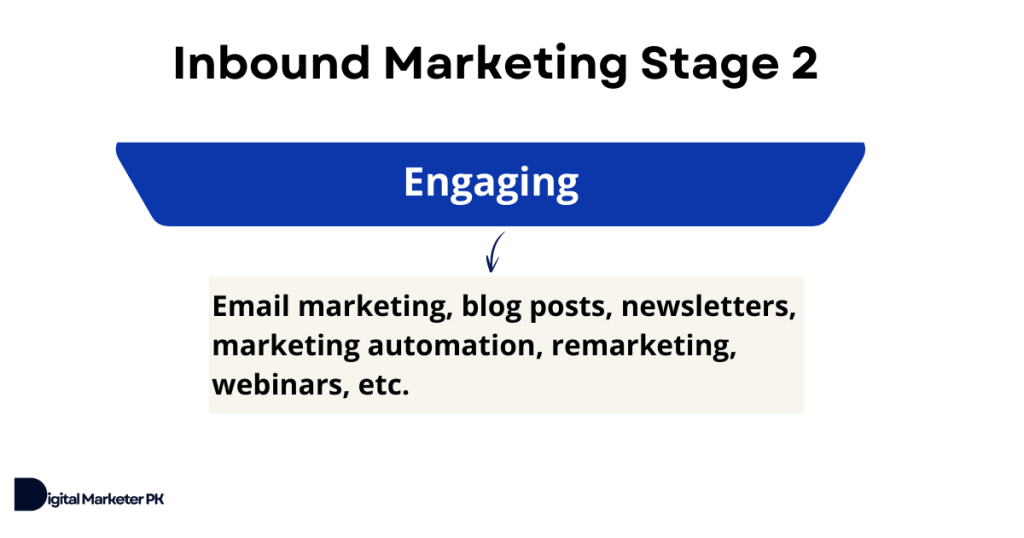
The idea is to address the pain points of your subscribers through freebies so they accept your authority in the niche and buy from you.
3. Delight Customers
A major focus of inbound marketing is on delighting customers by helping them use your product and get help when needed.
As a SaaS business, you need to ensure that customers know how to use your app so they achieve first success with it quickly. This can be best done via blogging, demo videos, email marketing, and other resources.
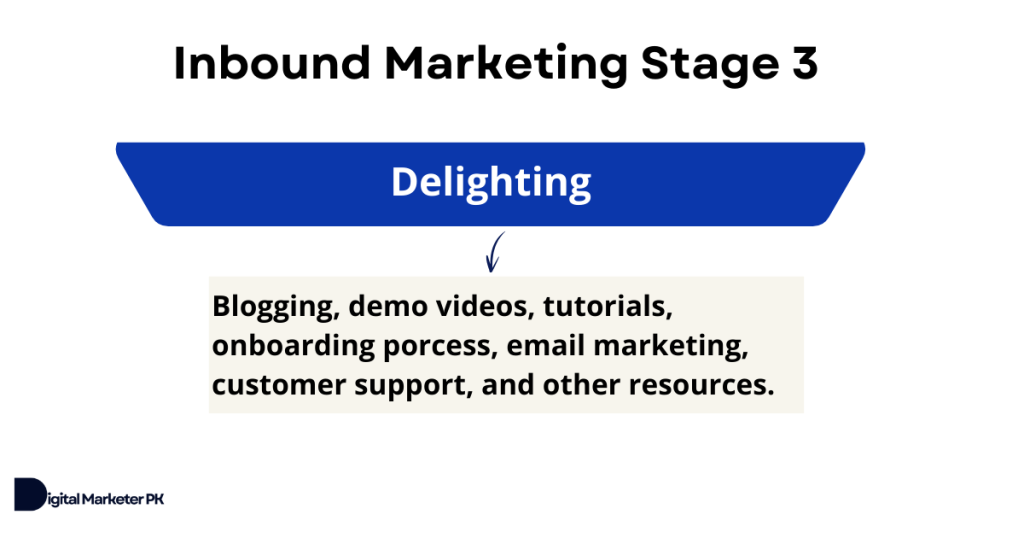
In the case of B2C SaaS, delighting customers can be automated through the onboarding process and embedding other features within your tool.
In the case of B2B SaaS companies, you need to engage at an individual level to deliver exceptional experience. For instance, you might have to assign an account manager or relationship manager to agency accounts for your SEO tool.
Delighted customers are more likely to stick with your business and become loyal customers.
How to Create an Inbound Marketing Strategy for a SaaS Company
Software businesses heavily rely on customer retention and loyalty. This makes inbound marketing ideal for SaaS businesses as it aligns with their funnel:

Converting customers into loyal brand advocates gets easier with inbound marketing.
Follow these steps to create an inbound marketing strategy for your SaaS brand from scratch:
1. Define Goal
Start with a clear purpose for your strategy. What exactly do you want to achieve with inbound marketing for your SaaS?
You can achieve a lot of long-term and short-term goals with inbound marketing for a SaaS business such as:
- Increase in website traffic
- More leads and sales
- Brand awareness
- Building authority
- Customer engagement
- Reducing churn rate
- Improving conversions
- Increasing customer loyalty
- Improve customer engagement
- Increase Customer Lifetime Value (CLV)
- Increase retention rate.
You need to be clear on the objective of your strategy.
The SMART goal is a decent framework for the creation of objectives. It helps you set Specific, Measurable, Achievable, Relevant, and Time-bound goals.

The core characteristics of a SMART goal are:
- Specific: The goal needs to be highly focused with a clear statement. It needs to be unambiguous and extremely narrowed.
- Measurable: It should be trackable. There should be relevant metrics and KPIs to monitor the progress of the goal. If you can’t measure it, you won’t be able to measure performance.
- Achievable: Your goal needs to be attainable. Setting unrealistic goals that you can’t achieve is useless.
- Relevant: The goal must align with your business objective, values, and philosophy. It also needs to be consistent with your marketing strategy. Relevance should also be considered in terms of available resources.
- Time-bound: It should have a time frame to achieve the desired goal.
Here’s an example of a SMART inbound marketing goal for a SaaS company:
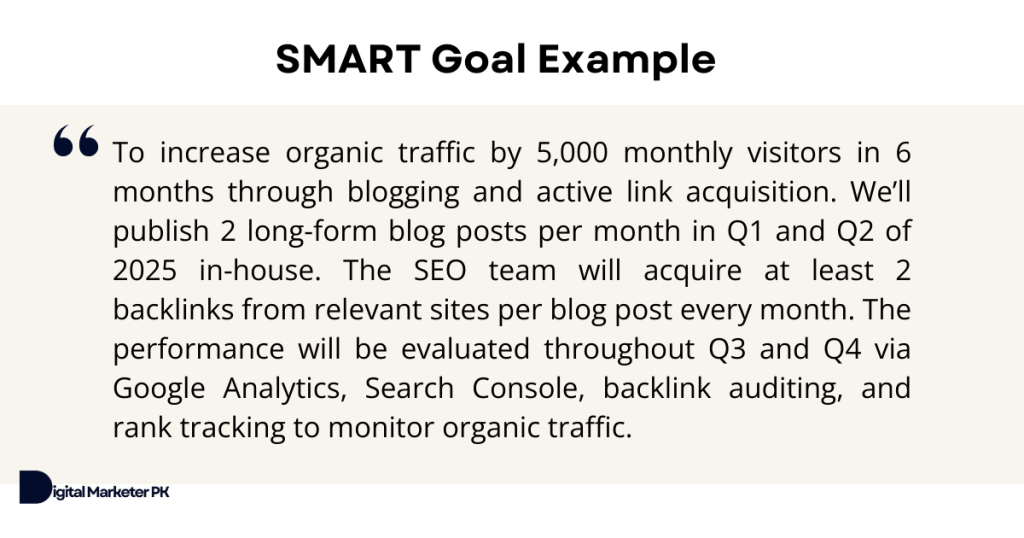
It is detailed and has pretty much everything that needs to be done.
You can add more details, obviously. Such as, you can add details of the content creation team, you can add details on specific content promotion techniques, and more.
The idea is to ensure that your inbound marketing goal tells anyone who reads it what’s your primary objective, what needs to be done, who needs to do it, the timeline, and how performance will be measured.
2. Identify Your Target Audience
A couple of days back, I was on a call with a US-based SaaS company that was in business for over a year. The company was spending more than $6,500 per month on blogging and PPC ads combined.
Their biggest problem was poor conversions.
I asked them who their primary target audience was.
The founder told me that their software can be used by any online business so there’s no specific audience they are targeting. We are targeting everyone from small to large businesses across industries.
This isn’t the first time I heard something like this from a SaaS business.
I always respond to them with a few lines:
You need to narrow down and choose a target audience. Create buyer personas and target them explicitly through content. You can’t target everyone with a single offer even if your app is for everyone.
It is absolutely necessary for a SaaS company to know precisely who your ideal customers are and what type of people you want to reach out to through content.
Even if your product is for everyone, you still need to narrow it down and start from one target group at a time. This has two major benefits:
- You can create a highly focused inbound marketing strategy with a clear purpose and goal
- It gets easier to grow your business when you start narrow and go broad.
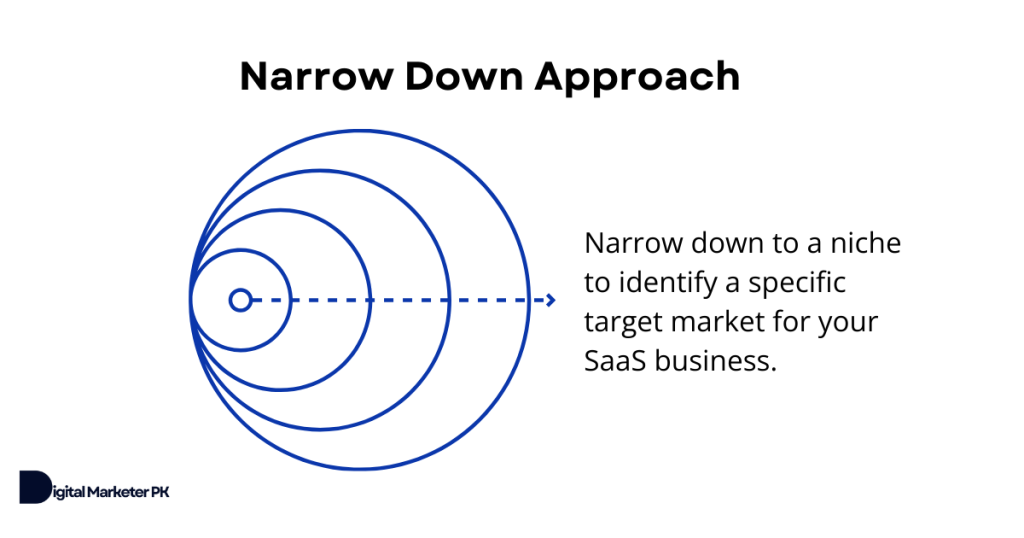
Buyer Personas
Understanding your audience and creating relevant content for them gets easier with buyer personas.
A buyer persona is a semi-fictional representation of who your ideal customers are. It is a one-page document that tells you everything about your target audience:

Here’s how to create it:
- Select your target market (e.g., small online business owners in the US)
- You then need to identify different target groups within your primary audience. For instance, you can create 3 target groups: Solopreneurs, businesses with less than 5 team members, and businesses that outsource to an agency
- Create one buyer persona for each target group as each group has different needs, pain points, motivation, budget, etc.
You can create a buyer persona from scratch or use a free template on Canva or HubSpot to get started.
Buyer persona development requires data to fill in. There are a few different sources to collect this data:
- Use existing data from your analytics tool, social media, CRM, and market research (e.g., Google Analytics)
- Leverage secondary data sources (e.g., census data and government statistics)
- Collect primary data from your audience (e.g., surveys and interviews).
The more detailed buyer personas are, the better. It gives you a complete overview of who your target audience is and how best you can connect and engage with them.
3. Create Content
Content creation and publication are the backbone of inbound marketing.
The content creation process requires you to have a content strategy that includes keyword research, setting up an editorial calendar, and content creation.
Keyword Research
You need to find keywords that your target audience uses in search engines to find answers to their problems. Targeting relevant keywords helps you reach your ideal customers through search engines and you can solve their queries (leading to authority and credibility).
There are multiple ways to find relevant keywords:
- Use existing data from Google Analytics and Search Console
- Find relevant keywords in a keyword tool like Google Keyword Planner (free) or Ahrefs (paid)
- Use related searches in Google to find more keywords
- Analyze your competitors to find what keywords they are targeting and ranking for.
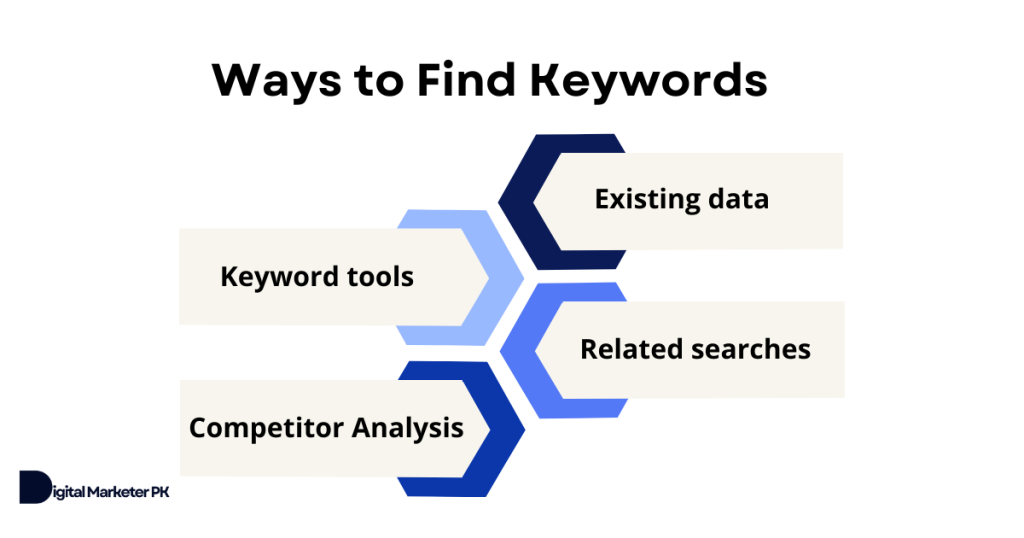
The right way to identify keywords to cover in a blog post from a list of keywords is:
- Target keywords that are valuable for your SaaS company and audience both
- The keyword should have a decent monthly search volume and should have low or medium competition (known as keyword difficulty).
Editorial Calendar
The appropriate keywords you want to target should be moved to an editorial calendar which helps you organize content creation and publication process.
Here’s an example of an editorial calendar:

Your editorial calendar should include the following details:
- Target keyword
- Search intent
- Article title
- Article purpose
- Who’ll write it
- Article type and format
- Publication deadline
- Internal and external links.
You can make it as detailed as you want. The idea is to streamline the content creation and publication process so your team knows everything.
Content Creation
The content you write and publish should be helpful, detailed, and factually correct. It should solve the reader’s query completely.
For instance, if you are writing a blog post on “How to improve team productivity for a small business”, it should give a complete overview to the readers so they leave your blog fully satisfied.
If they don’t, it’ll negatively impact search rankings as they’ll re-run the same search query. This indicates to Google that the query wasn’t addressed completely by the previous article.
The best way to create fulfilling content is by understanding search intent.
User intent, keyword intent, or search intent refers to the purpose of a search query. It is the reason why a user enters a search query in Google.
People run search queries to address 5 major types of intents:
- Informational to find information about anything (e.g., what is a backlink)
- Commercial investigation to compare different alternatives during the research phase (e.g., best tire crushers)
- Commercial to find more about a company or product before making a purchase (e.g., PS5 discount)
- Transactional to buy a specific product or service (e.g., buy PS5)
- Navigational to go to a specific page or site (e.g., Amazon Prime login)

You need to understand the search intent and address it when writing content. The best way to do this is by looking at the top search results in Google for the keyword you are targeting.
In the example below, Google is ranking the list of best CRM tools for the search query “best CRM tool” which means it has commercial intent.

If you try to rank your CRM company on the first page of Google for the keyword “best CRM tool”, you’ll have a very tough time.
Why?
Because searchers aren’t looking for a single CRM tool rather, they are interested in looking at a list of tools so they can choose one.
You can’t rank for a keyword without understanding the intent and sticking with it.
A simple rule: Scan the first page of Google and see what type of content is ranking already. Create a similar format and type of content.
4. Promote Content
Creating and publishing awesome content isn’t enough. It’s just the beginning.
You need to promote content after it goes live.
If you have a small or new (or even if you have a large) SaaS company with low authority (DA or DR), you’ll notice that your blog posts don’t rank well in Google or any search engine. No matter how many posts you publish, it won’t move the needle unless you promote it religiously.
On-Page SEO
On-page and technical SEO of your website and individual pages should be sound. It is a core ingredient for better search visibility.
Poor on-page SEO will negatively impact the crawling and indexing of new content.
Here’s an on-page SEO checklist for SaaS sites that covers everything you need to look into when publishing new content:
- Optimize HTML tags including title, heading, alt, and others
- Create an epic meta description that describes the article’s purpose
- Write a friendly URL slug
- Add relevant internal links
- Properly format and structure content. Distribute it into different sections with short paragraphs and ensure there aren’t any factual or grammatical errors in the content
- Use responsive theme
- Improve Core Web Vitals of the page by following recommendations by PageSpeed Insights
- Improve readability by choosing a decent color scheme, add white space, and improve UX and navigation.
Backlinks
Research by Ahrefs shows that 96.55% of content gets no traffic at all from Google. This is based on an analysis of 14 billion pages so you can generalize these findings.

The study highlighted the top 3 reasons why these pages weren’t getting any traffic:
- No search volume (= poor keyword research)
- No backlinks (= poor content promotion)
- The content doesn’t match search intent (= poor keyword research).
You might choose a great keyword with high search volume and you can create epic content that aligns with the search intent, but if your page doesn’t have any backlinks, it won’t rank.
Promotion is the key to success with inbound marketing.
The reason why most SaaS businesses stop publishing new content is that their existing content doesn’t rank and doesn’t drive any organic traffic.
That’s not because they have low quality content, but that’s because they haven’t invested anything in content promotion.
Publish and sit back doesn’t work.
If some guru tells you they created an epic blog post that is ranking on the first page of Google the next morning. That’s because their domain has high authority which passes the link value to internal pages (leading to an immediate hike in SERPs).
You can’t replicate the same model in your domain which has a low authority (DR and DA). It doesn’t just work like that.
A study by Backlinko revealed that the number of referring domains is one of the most important ranking factors. It analyzed 11.8 million Google search results and found that pages with more backlinks always outperform pages with a low number of backlinks in SERPs:

The best way to promote your content after it goes live is by acquiring natural, relevant backlinks. Here’s how to do it:
- Reach out to websites that have already linked to similar content and show them your content (which needs to be better than the content they are already linking to)
- Publish guest posts on relevant sites. This requires manual outreach
- Analyze competitor backlinks and outreach to the same sites and ask for link inclusion. This only works if you have better content than they are linking to
- Leverage resource link building by finding resource pages that have links to resource topics
- Create visual assets such as interactive infographics and share those with relevant sites so they can add them to their existing or new content pieces with a link to your site
- Internally link to new blog posts from powerful pages to transfer link value.
Content Repurposing
A great way to increase the reach of your published content is by changing the format and republishing it to a new channel, known as content repurposing.
It is a perfect approach to promoting new content.
It is a cost-effective and less time-consuming technique to increase website traffic as you reach and connect with your target audience on different channels.
For instance, you can create social media posts from a blog post and publish those across social media accounts. You can then repurpose the same article into an email and send it to your list for higher engagement. You can create an infographic from the same content and use it for outreach campaigns to acquire backlinks.
And so on.
You can use a single piece of content in numerous ways to reach more audience, drive traffic, generate backlinks, and use your content to its fullest capacity:
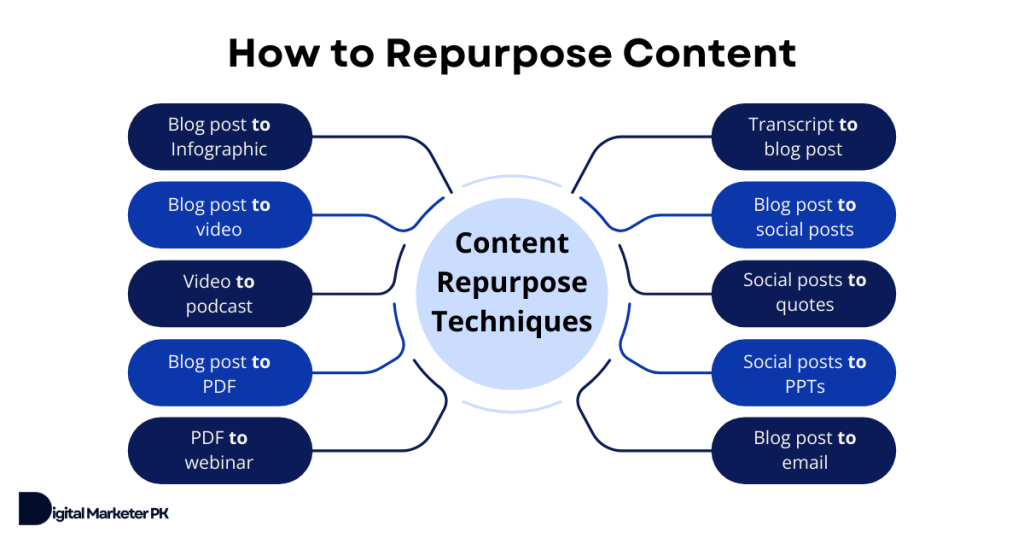
5. Conversion Optimization
Tracking performance and optimizing your inbound marketing strategy for conversions is a continuous process.
If you think promoting content and generating backlinks will do wonders, well, not really.
There’s a lot to be done, especially in terms of conversion optimization.
The content will drive traffic to your SaaS blog, but not all visitors will convert. Traffic without conversions is useless.
Traffic doesn’t generate money, paid sign-ups do.
You need to do a few things to convert visitors into leads:
- Offer lead magnets (free, highly valuable resources that you give away to your audience in exchange for their email address) and that’s how visitors enter your sales funnel
- Create multiple lead magnets relevant to your SaaS product and the content topics you cover
- Nurture leads through relevant content as they move down the funnel.
HubSpot does exceptionally well in converting visitors into leads. See in the example below, they pitch visitors a relevant lead magnet so visitors enter their sales funnel:
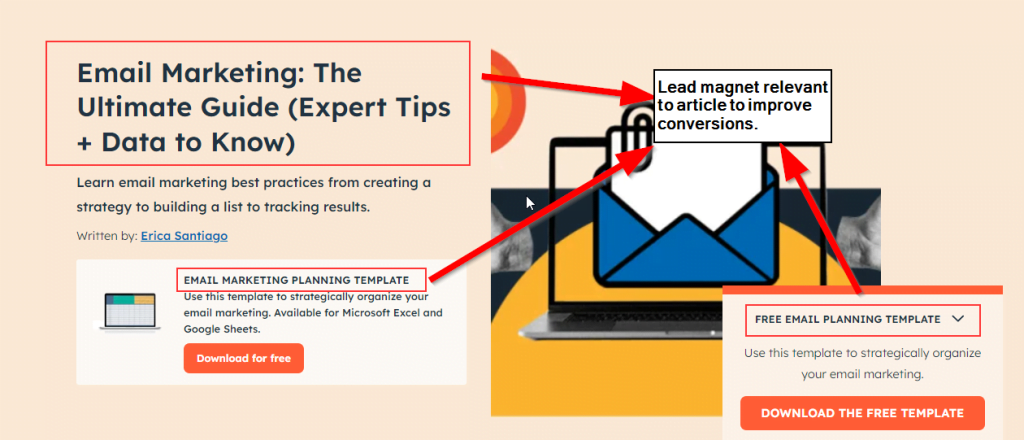
If you visit an article on influencer marketing, you’ll see a lead magnet on influencer marketing (not email marketing):
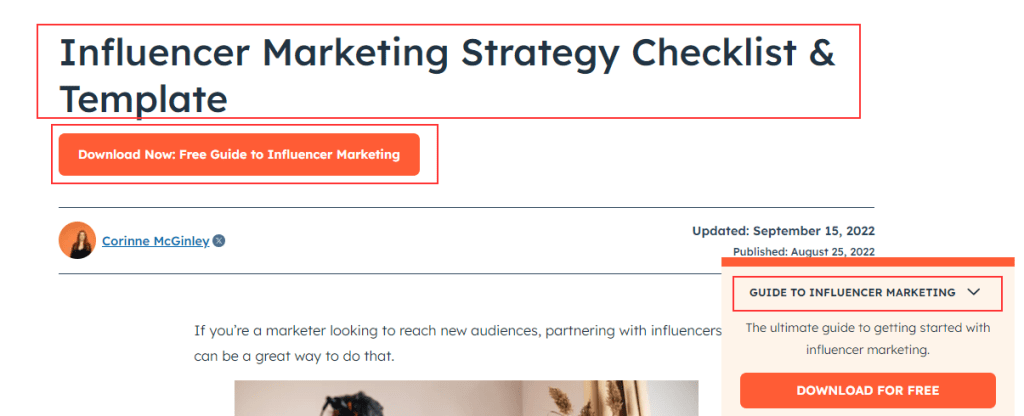
They have created several lead magnets that are pitched to the right people on the right page to capture their email addresses.
Once you have the email address, you can continue to engage and delight them as they move from one funnel stage to the next.
Here’s how to create and offer lead magnets to your audience on your SaaS blog:
- Create highly valuable resources relevant to your software and content. Common lead magnets include guides, templates, checklists, free trials, discount coupons, and more
- Create forms and popups to capture visitors’ email addresses
- Link your form to an email marketing tool like MailChimp to deliver lead magnets automatically
- Use your email marketing platform to create emails to engage with new subscribers
- Connect your email app with your CRM tool and Google Analytics to optimize the funnel.
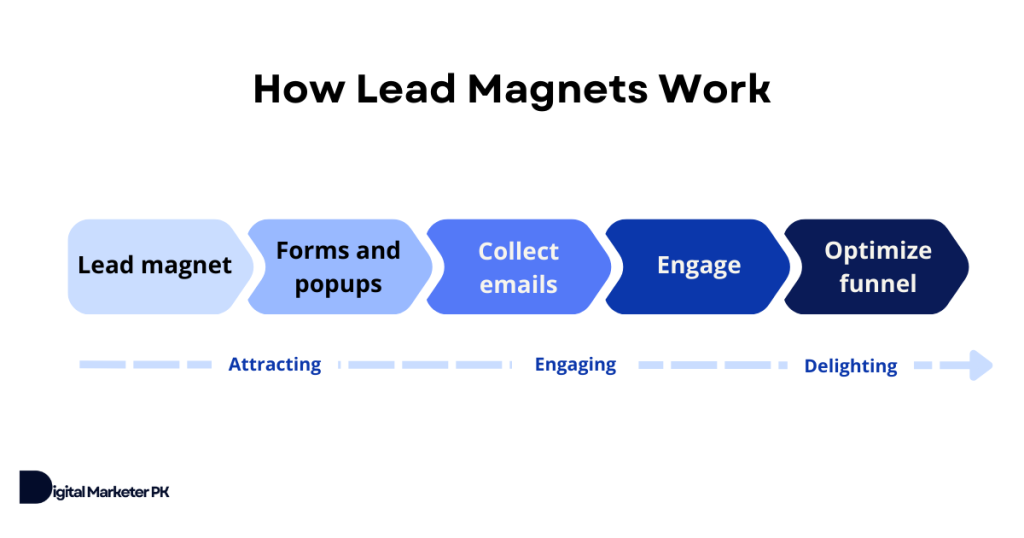
Inbound marketing requires continuous monitoring to figure out what type of content works best, which buyer personas convert better, what lead magnets work great, how and where your funnel leaks, and so on.
That’s how you grow and scale your SaaS business with content marketing.
Final Words
Inbound marketing is all about content, promoting your published content, converting visitors into customers, and building long lasting relationships with your customers.
It is a sustainable and scalable marketing strategy that can be used by any SaaS company located anywhere in the world.
Does it take time?
Yes.
Does it need trial and error?
Yes.
Does it require consistency?
Yes.
If you are OK with these, step ahead and create an inbound marketing strategy for your SaaS today.
Need help?
Get in touch with us and we’ll be happy to help your SaaS grow with content.



